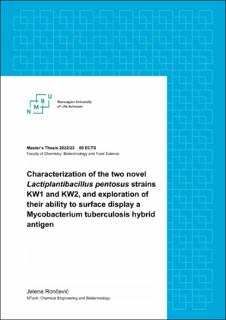| dc.description.abstract | Many lactic acid bacteria are natural inhabitants of the human gut and are considered safe for human consumption. Food-grade lactic acid bacteria from the genus Lactiplantibacillus are generally tolerant to highly acidic environments, allowing them to survive and colonize the human
gastrointestinal tract. Furthermore, certain species can have vaccine adjuvant effects through direct interactions with the human immune system. Thus, Lactiplantibacilli are promising candidates for the delivery of antigens to mucosal surfaces.
The aim of this study was to characterize the two novel Lactiplantibacillus pentosus strains, KW1 and KW2, isolated from table olives; and explore their capability to surface display a Mycobacterium tuberculosis-derived hybrid antigen. The L. pentosus strains were evaluated by analyzing cell morphology and growth analysis. The microscopy analysis showed that L.
pentosus KW1 and KW2 were morphologically similar and rod-shaped. The optimum growth temperatures were found to be in a range from 33 to 39 °C. In addition, the present study conducted a functional analysis of the inducible gene expression system (pSIP) to evaluate its
applicability for use in L. pentosus. It was shown that the pSIP system is strictly regulated in KW1 and KW2, where the protein production of mCherry, used as a reporter protein, increased more than 20-fold upon full induction. The protein production of mCherry was found to be
highest at 37 °C and L. pentosus KW1 was the most efficient producer.
Eight recombinant bacteria were constructed for surface exposure of the H56 hybrid tuberculosis antigen. Four different anchors derived from the genome of KW1 and KW2 were selected, and translationally fused to the antigen, generating the eight recombinant strains. The selected
anchors were: (1) an N-terminal transmembrane (NTTM) anchor that non-covalently attaches the antigen to the cell membrane, (2) a lipoprotein anchor to covalently attach the antigen to the cell membrane, (3) a LysM anchor for non-covalently anchoring of the antigen to the cell wall, and (4) an LPxTG peptidoglycan anchor to covalently attach H56 to the cell wall. The recombinant strains showed only a slight reduction in growth, except for strains harboring NTTM-anchored antigens. Western blot analysis confirmed antigen production for seven out of eight recombinant strains. Furthermore, flow cytometry analysis detected exposed antigens on the surface for all recombinant strains except for the KW2_LPxTG anchor. The strongest fluorescent shift was observed in L. pentosus KW1, especially with lipoprotein and LysM-anchored antigens.
The successful secretion and surface exposure of the tuberculosis antigen show that these recombinant bacteria are promising candidates for antigen delivery. The analyses demonstrated that L. pentosus KW1 seems to be the most promising strain for further development as a vaccine delivery vehicle. | |
